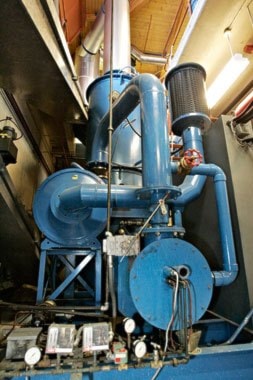Deep in the bowels of Yukon College sits a wondrous machine—a furnace that can eat almost anything, from scrap wood to garbage, and burn it so cleanly that almost no emissions are produced.
It’s called a fluidized bed gasifier, and it was installed, probably at great expense, when the new campus was built in 1988.
It runs, but only if an Outside egghead twiddles its knobs by hand. Its electronic controls and sensors never worked right.
In the two decades the gasifier has sat in the college boiler room, it’s only worked during experiments. It’s never seen daily use.
New territorial politicians come and go. More than a few have vowed to get the gasifier running. None have succeeded.
Yet.
Yukon’s Department of Energy hopes to have the gasifier heating the college by September, said analyst Bob Collins.
That’s “if things go right.” And, in the gasifier’s long history, that’s rarely been the case.
Attention fell once again to the gasifier during preparation of the Yukon’s new energy strategy, released last month.
The furnace, which is fueled by wood chips, could help solve a heap of energy problems.
It could reduce demand on Yukon’s strained hydroelectricity system.
It could curb greenhouse gas emissions.
It could save money, as wood chips are a cheaper alternative to diesel and heating oil.
It could be fed beetle-killed wood, which may otherwise rot and go to waste.
And it could also provide a market for waste wood, helping shore up profits for Yukon wood workers.
But for any of this to happen, someone first needs to make the thing work. And fixing it won’t be cheap.
A 2005 report suggests it would cost 0,000 to repair the gasifier. But that money would be recouped in less than five years through fuel savings, the report estimates.
The college spends more than million annually on heating fuel and purchasing secondary power from Yukon Energy during nonpeak periods, says the report.
Energy officials are now revising cost estimates for fixing the gasifier. Their work should be done at month’s end, said Collins.
Why does this surge of interest follow five years of waiting after the release of previous reports?
There was likely little urgency to get the gasifier running in previous years, when the college managed to heat itself mostly with surplus hydropower, said Collins.
Now that surplus is drying up.
“In 2004 it was a good idea, but not as good an idea as it is today,” he said.
Politics have changed in five years, too. Climate change is a far bigger deal now.
Then there’s the energy strategy. It promises, among other things, to “build a wood-based bio-energy industry in Yukon” and “build a local wood market for wood energy technologies and products.”
Gasification is not new. It was used in the 1800s to produce gas for lighting and cooking. During Second World War fuel shortages, wood gas generators powered some automobiles in Europe.
The technology works by heating fuel—whether it be coal, petroleum or wood chips—to such high temperatures that, when mixed with the right amount of oxygen, it vapourizes to become synthetic gas.
In recent years, climate change has revived interest in wood gasification as a relatively clean alternative to burning fossil fuels.
In Gussing, Austria, an industrial wood-chip gasifier has powered the village since 2002.
Special gasifiers are even being used to produce electricity from municipal garbage in Canadian cities. A private company began doing so in Ottawa in February of 2008. The city of Red Deer, Alberta, plans to start gasifying garbage this year.
Scientists from Natural Resources Canada tested the college gasifier in 2004. They managed to make it work for a brief period, although the electronic controls failed so they resorted to tweaking knobs by hand.
The trial ended early for two reasons. Wood chips used as fuel were of inconsistent size and jammed up the feeder. And the paint that coated one boiler began to blister, smoke and burn.
But it worked.
For the furnace to work without the help of Outside eggheads, it would need new electronic controls, sensors and other upgrades.
It would also need a steady supply of wood chips of the right size and moisture content.
Such a supply has proven a challenge in the past. Elijah Smith Elementary School has a furnace equipped with a wood-chip feeder. But the feeder was only used for a brief period.
Because it was fed chips of the wrong size, it kept clogging.
Today, wood producers in Yukon are calling on the territory to dust off these machines and help create a market for chips that would otherwise go to waste.
Judging by the work underway to get the gasifier online, it looks like they’ve been heard.
The next test will be whether money to fix the gasifier appears in the 2009-10 territorial budget.
The bigger test to follow will be whether anyone can make it work properly.
Contact John Thompson at
johnt@yukon-news.com.
